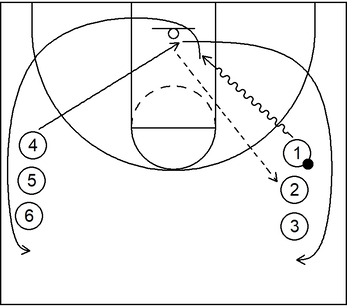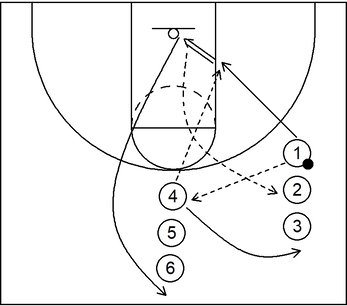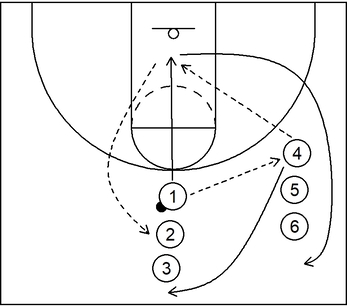What is a layup in basketball
A layup in basketball consists of action that occurs when an offensive player in possession of the ball takes a close-range shot, particularly within the lane area, directly over the front of the rim or off the backboard.
It should also be noted that an offensive player would typically jump in the air utilizing one foot or both feet to shoot the layup, especially while moving with or without the basketball.
Furthermore, when an offensive player jumps in the air to shoot the layup, this could potentially decrease the likelihood of the layup being easily blocked by a defender of equal or less size.
What’s more, as mentioned previously, a layup is a close-range shot, which means it is taken near the basket as opposed to a mid-range shot or three-point range shot, which are taken near the perimeter areas of the court.
Nevertheless, in addition to being a close-range shot, a layup is also a type of field goal shot, which is primarily emphasized as one of the common types of basketball statistics, particularly as it relates to organized competition.
Basically, within organized play, each time an offensive player attempts a layup, that would be documented by a statistician as a field goal attempt, typically abbreviated as FGA, and each time that an offensive player makes a layup, that would be documented by a statistician as a field goal made, typically abbreviated as FGM.
In addition to that, it is also possible to gain knowledge of a player’s overall field goal percentage by calculating the amount of field goals that same player made divided by the total amount of field goal attempts.
So, if a player makes 4 field goals out of a total of 10 field goal attempts, then that same player would have a field goal percentage of 40%.
Moreover, because a layup is a close-range shot, that makes it one of the easiest shots for an offensive player to consistently make, especially if a defender is not attempting to block or contest the layup.
In other words, an offensive player should typically be able to make an uncontested layup at a much higher rate than a mid-range jump shot or three-point jump shot.
As a basic example, let’s say that an offensive player attempts a total of 10 field goal attempts.
Let’s also say that 5 of those 10 field goal attempts were uncontested layups while the other 5 were mid-range shots or three-point shots.
With that brief information at hand, the offensive player should generally be able to make at least 4 (if not all 5) out of the 5 uncontested field goal layups.
However, if the offensive player were to only make 2 or 3 out of the 5 mid-range or three-point field goal shots (regardless if those shots are being contested or not by a defender), then that would be a logical possibility as the player is further away from the basket.
That is to say, it is generally more challenging for a player to make field goal shots with a high level of consistency the further that player moves away from the basket, especially when compared to layups, which are very close to the basket.
This also explains why traditional post players such as the power forward and center would commonly have a higher field goal percentage than traditional perimeter basketball positions such as the point guard, shooting guard, or small forward.
In simple terms, since traditional post players score most of their points around the basket, which includes layups as well, those same players would naturally have a higher overall field goal percentage in comparison to perimeter-based players, who would generate most of their points via mid-range or three-point jump shots.
What are the common types of layups
The common types of layups include the basic layup, the power layup, the reverse layup, and the finger roll.
Basic layup
The basic layup consists of action that occurs when an offensive player in possession of the basketball near the rim, jumps in the air with one foot, and shoots the ball off the corner of the backboard’s inner rectangle.
An offensive player could consider using the basic layup when they are in motion towards the basket and there is not a defender in close proximity to potentially block the basic layup or cause the offensive player to possibly alter the layup or miss the layup altogether.
The two sub-types of basic layups are the left hand basic layup and the right hand basic layup.
An offensive player could perform the left hand or right hand basic layup immediately after catching the ball or while dribbling the ball.
This is a brief example that showcases how an offensive player, denoted as player A could potentially execute a left hand basic layup after catching the ball via a pass from an offensive teammate, denoted as player B.
Additionally, for this simple example, player B will throw a basic chest pass, although it is possible to throw some other type of air pass or even a bounce pass to player A.
During the initial phase, player A should begin on the left side of the court, particularly near the left side wing area beyond the three-point line.
Player B could also begin near the top behind the three-point line or near the high post area within the three-point line.
Next, player A should take a few steps towards the basket and as that occurs, player B should pass the ball to player A.
In general, player B should ideally pass the ball just before player A reaches the lane line on the left side.
Also, as a side note, player B should pass the ball ahead of player A because otherwise, the ball would end up behind player A due to the timing of the pass.
From there, as the ball is in the air, player A should catch it with both hands and at the same time while still in motion, player A should take a penultimate step towards the rim with their left foot.
Following that, while still holding the basketball with both hands, player A should take a final step towards the rim with their right foot and even more particularly, the right foot should be in the lane or at the very least, touching the lane line on the left side, preferably just below the low post block.
Furthermore, as that happens, player A should immediately jump in the air with that same right foot and while in the air, player A should shoot the ball with their left hand towards the left corner of the backboard’s inner rectangle to complete the left hand basic layup.
These steps would also apply to a right hand basic layup after catching the ball via a pass from a teammate.
However, the steps would be in reverse. That is to say, player A would start near the right side of the court, take the penultimate step with the right foot while catching the ball, take the final step with the left foot, jump in the air off that same left foot, and then shoot the ball with the right hand.
This is a brief example that demonstrates how an offensive player, denoted as player A, could potentially execute a right hand basic layup while dribbling.
During the initial phase, player A should begin on the right side of the court, particularly near the right side wing area behind the three-point line.
Next, player A should begin dribbling the basketball with their right hand while moving towards the rim.
Generally speaking, just before reaching the lane line, player A should secure the ball by gathering it with both hands and then take their penultimate step with their right foot.
Afterwards, while still holding the ball, player A should take their final step towards the rim with the left foot and immediately jump in the air with that same left foot.
Following that, while in the air, player A should shoot the ball with their right hand towards the right corner of the backboard’s inner rectangle to complete the right hand basic layup.
These steps would also apply to a left hand basic layup while dribbling but in reverse.
That is to say, player A would begin near the left side of the court, dribble towards the rim, take the penultimate step with the left foot while holding the ball, take the final step with the right foot, jump in the air from that same right foot, and then shoot the ball with the left hand.
Power layup
The power layup consists of action that occurs when an offensive player in possession of the basketball near the rim, jumps in the air with both feet, and shoots the ball off the corner of the backboard’s inner rectangle.
An offensive player could consider using the power layup while initially in motion but at the same time, a defender is in close proximity to potentially block the basic layup or cause the offensive player to possibly alter the layup or miss it altogether.
The power layup is typically a more practical choice over the basic layup when a defender is in close proximity because the offensive player has an opportunity to read the defense and react accordingly.
Reverse layup
The reverse layup consists of action that occurs when an offensive player in possession of the basketball near the rim, jumps in the air and shoots the ball on the opposite side of the backboard’s inner rectangle.
An offensive player could consider using the reverse layup when a defender could potentially block the basic layup and at the same time, executing a power layup is not very feasible as well.
For example, if a defender has a significant height advantage and going for a power layup could still result in a blocked shot, then the offensive player could consider the reverse layup as an alternative scoring option.
Finger Roll
The finger roll is a type of layup shot that occurs when an offensive player in possession of the basketball in close proximity to the basket, jumps in the air, and at the peak of that jump, rolls the ball over the front of the rim with an underhanded shooting motion.
An offensive player could consider using the finger roll when it is not very practical to use the backboard as with other types of layups.
For example, if an offensive player is dribbling down the court directly in front of the basket, then it would probably be best to try a finger roll as opposed to attempting a layup off the backboard.
Moreover, an offensive player could consider using the finger roll when there are no adjacent defenders in close proximity that could block the shot.
What are examples of simple layup drills for a basketball team
Drill 1

This is an example of a simple layup drill for a basketball team.
The initial setup features two lines with three players in each line near the left side wing and right side wing respectively.
Additionally, for this drill, players on the right side start with possession of the basketball but that could easily be reversed so that players on the left side began with the ball.
Besides that, it should also be mentioned that for this drill and any other drills, the numbers for each player are there for simplicity purposes and are not indicative of standard basketball positions.
So, player 1 does not necessarily have to be a point guard, player 2 does not have to be a shooting guard, and so forth.
Moving forward, to execute the drill, 1 dribbles toward the basket with the right hand.
Following that, upon reaching the lane line, 1 gathers the ball with both hands, takes the penultimate step with the right foot, takes the final step with the left foot, jumps in the air from that same left foot, and makes a layup by shooting the ball off the right side corner of the backboard’s inner rectangle with the right hand.
Moreover, as that happens, 4 cuts to the basket from the left side wing to catch the ball with two hands as it falls through the basket ring after 1 makes the layup.
Next, 2 receives the ball from 4 while 4 moves to the back of the line on the right side and 1 moves to the back of the line on the left side.
Afterwards, 2 would dribble towards the basket to make a right hand layup while 5 gathers the ball out of the basket ring and so forth.
It should also be stated that each player should move to the back of their respective lines nearest to the sideline as to not disrupt the flow and movement of other teammates.
Drill 2

This is an example of a simple give and go layup drill for a basketball team.
Prior to drill execution, there are two lines near the top and the right side wing, although it would be possible to shift the wing line from the right side to the left side as a variation of this drill.
In addition to that, players near the right side wing have initial possession of the ball.
To begin the drill, 4 receives the ball from 1 and afterwards, 1 immediately cuts to the basket.
Next, 4 should throw a basic lead pass, which could be a basic chest pass or bounce pass, towards the lane line area and then proceed to the back of the line near the right side wing area.
From that point, 1 should catch the pass thrown by 4, simultaneously take a penultimate step with the right foot, and then a final step with the left foot.
Following that, 1 should jump in the air from that same left foot and shoot the ball off the top right corner of the backboard’s inner rectangle.
After making the layup, 1 should collect the ball as it goes through the basket ring, pass the ball to player 2, and proceed to the back of the line at the top.
Once that portion of the drill gets completed, 5 would receive the ball from 2 who would then cut to the basket and receive the ball again from 5, which would then be followed up with a right hand layup, and so forth.
Drill 3

This is another example of the basic give and go layup drill for a basketball team.
This time, players start with the ball at the top while wing players execute the pass back action.
To begin the drill, 4 receives the ball from 1 who immediately cuts straight down the lane to the basket, receives the ball again from 4, and can make a layup, particularly as a finger roll.
From there, 1 collects the ball as it goes through the basket ring, passes the ball to player 2 at the top, and then cuts to the back of the line near the right side wing.
Also, 4 would proceed to the back of the line at the top and then the drill would continue with 5 receiving the ball from 2.